|
|
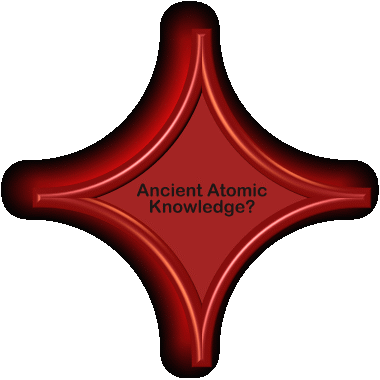
from
OOParts
Website
|
"The LORD saw how great man's wickedness on the earth had become, and that
every inclination of the thoughts of his heart was only evil all the time.
The LORD was grieved that he had made man on the earth, and his heart was
filled with pain. So the LORD said, "I will wipe mankind, whom I have
created, from the face of the earth--men and animals, and creatures that
move along the ground, and birds of the air, for I am grieved that I have
made them."
Genesis 6...
Gurkha,
flying a swift and powerful
vimana
hurled a single projectile charged with all the power of the Universe.
An incandescent column of smoke and flame as bright as the thousand suns rose in all its
splendor...
a perpendicular explosion
with its billowing smoke clouds...the cloud of smoke
rising after its first explosion
formed into expanding round circles
like the opening of giant parasols... it was an unknown weapon, an iron thunderbolt,
a gigantic messenger of death, which reduced to ashes the entire race of the
Vrishnis and the Andhakas.
...The corpses were so burned as to be unrecognizable.
The hair and nails fell out; pottery broke without apparent cause, and the birds turned white.
After a few hours all foodstuffs were infected... to escape from this fire.
The soldiers threw themselves in streams to wash themselves and their equipment.
Ancient verses from the Mahabharata: (6500 B.C.?)
|
|
Contents
Additional Information
Introduction
"Thirteen
nuclear reactors existed in "prehistoric" periods along the
200-metre mine bed at Oklo - it was discovered in 1972, and they
were comparable to the modern nuclear reactor in power and heat
combustion.
This mine had the capability of enabling self-sustained nuclear
chain reactions". This discovery shocked the entire scientific
community back in 1972 - but hold on - we'll get back to this
later. |
As we look at a bit of what is being called evidence of ancient atomic
warfare (or simply atomic explosions), it is important to make a
distinction.
It is important that we can establish through available evidence some seen
on other pages here-- that: the Bible does in fact mention dinosaurs, that
man and dinosaurs co-existed as the Bible would indicate; that DNA is proof
of a creator, that the worldwide flood of Noah did happen, and that the
world was created in one week as the Word says.
We have pondered the question of the technological sophistication of pre-flood civilizations. Atomic
warfare or atomic capability would be
another indication of this sophistication and little else. It may be that if
it existed it was part of the wickedness that God saw, as referenced by the
quote from Genesis 6 at the top of this page. The most interesting story on
these pages is the absolutely true story of the Oklo mines.
On the other hand, there will be consternation that would
result among materialists/evolutionists, if it could be proven that this
technology did in fact previously exist. It would be very difficult to fit
that knowledge into the current paradigm, wouldn't it?
As for believer's such a confirmation could only bolster our confidence that
when we say to materialists that "there are things in Heaven and earth that
are not dreamed of in your philosophy", that that is proving truer every day.
There are some interesting things to consider, and
we should just take a look at it and form a conclusion. It may well be
that we will reject all of the "evidence" or merely some of it. It's
certainly worth a couple of minutes of our no doubt valuable time to give a
look.
The "evidence" will largely fit in four categories.
-
Descriptions in what
are thought to be the oldest written texts by man still in existence
-
Discovery of archeological sites which demonstrate characteristics,
including high levels of radiation, consistent with an atomic explosion
-
Physical evidence (changes in the sand) similar to those found at the
site of current day atomic explosions
-
Evidence of depleted uranium
with plutonium products
The following item appeared in the
New York Herald Tribune on February 16,
1947 (and was repeated by Ivan T. Sanderson in the January 1970 issue of his
magazine, Pursuit):
Back to Contents
Atomic Explosions Produce Glass
When the first atomic bomb exploded in
New Mexico, the desert sand turned to
fused green glass.
This fact, according to the magazine Free World, has
given certain archaeologists a turn. They have been digging in the ancient
Euphrates Valley and have uncovered a layer of agrarian culture 8,000 years
old, and a layer of herdsman culture much older, and a still older caveman
culture.
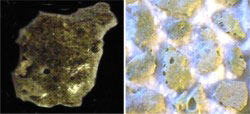
Olive green Trinitite formed in New Mexico as a result of atomic
testing in 1945
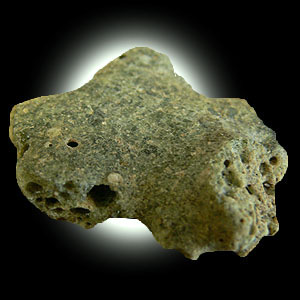
Trinitite
The bomb melted the sand into
this greenish glass. It was named trinitite after Trinity
(Trinity was the first place
in history, where a plutonium bomb exploded)
Recently, they reached another layer of fused green glass.
It is
well known that atomic detonations on or above a sandy desert will melt the
silicon in the sand and turn the surface of the Earth into a sheet of glass.
But if sheets of ancient desert glass can be found in various parts of the
world, does it mean that atomic wars were fought in the ancient past or, at
the very least, that atomic testing occurred in the dim ages of history?
This is a startling theory, but one that is not lacking in evidence, as such
ancient sheets of desert glass are a geological fact. Lightning strikes can
sometimes fuse sand, meteorologists contend, but this is always in a
distinctive root-like pattern.
These strange geological oddities are called fulgurites and manifest as
branched tubular forms rather than as flat sheets of fused sand.
Therefore, lightning is largely ruled out as the cause of such finds by
geologists, who prefer to hold onto the theory of a meteor or comet strike
as the cause. The problem with this theory is that there is usually no
crater associated with these anomalous sheets of glass.
Brad Steiger and Ron Calais report in their book, Mysteries of Time and
Space, that Albion W. Hart, one of the first engineers to graduate from
Massachusetts Institute of Technology, was assigned an engineering project
in the interior of Africa.
While he and his men were traveling to an almost
inaccessible region, they first had to cross a great expanse of desert.
"At the time he was puzzled and quite unable to explain a large expanse of greenish glass which covered the sands as far as he could see," writes
Margarethe Casson in an article on Hart's life in the magazine Rocks and
Minerals (no. 396, 1972).
She then goes on to mention:
"Later on, during his life he passed by the
White Sands area after the first atomic explosion there, and he recognized
the same type of silica fusion which he had seen fifty years earlier in the
African desert."
Interestingly, Manhattan Project chief scientist
Dr J. Robert Oppenheimer
was known to be familiar with ancient Sanskrit literature.
In an interview
conducted after he watched the first atomic test, he quoted from the Bhagavad Gita:
"'Now I am become Death, the Destroyer of Worlds.' I suppose
we all felt that way."
When asked in an interview at Rochester University seven years after the
Alamogordo nuclear test whether that was the first atomic bomb ever to be
detonated, his reply was,
"Well, yes, in modern history."
David Hatcher
Childress
in Nexus magazine
Back to Contents
LIBYAN DESERT GLASS
Pieces of Libyan Desert Glass weighing as much as 16 pounds are found in an
oval area measuring approximately 130 by 53
 kilometers. The
clear-to-yellowish-green pieces are concentrated in sand-free corridors
between north-south dune ridges. kilometers. The
clear-to-yellowish-green pieces are concentrated in sand-free corridors
between north-south dune ridges.
The origin of this immense deposit of glass has been attributed by some to
ancient nuclear explosions and alien activities, but investigating
scientists have always been satisfied with a meteor-impact hypothesis.
A recent study (abstract below) also opts for this explanation, although no
one has found a crater of suitable size or other supporting evidence.
Back to Contents
More on Libyan Desert Glass
Libyan Desert Glass is found widely scattered over an area 130 km north to
south by 53 km east to west.
The Libyan Desert of Egypt is one of Earth's most remote and inhospitable
regions. Uninhabited, windblown and foreboding, the Sand Sea, near the Gilf
Kebir Plateau, was nonetheless the site of a remarkable discovery in 1932.
The Egyptian Desert Surveys under the able direction of Englishman Patrick
A. Clayton (1896-1962) recovered specimens (about 50 kg) of an unusual,
often beautiful, translucent to transparent, yellowish-green gem-like, high
silica natural glass.
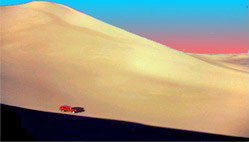
The Area Where The Glass Is Found
After the 1932 discovery of Libyan Desert Glass, only two other expeditions
(both of the 1930's) were undertaken to the location until 1971.
This latter exploration involved three scientists stopping over for only two
hours and collecting some 24 samples of the glass. During this brief visit,
the expedition accidentally found the site of a forced landing of an
Egyptian aircraft with the remains of nine men.
The failure of Egyptian authorities to find the downed airplane for over
three years is solemn validation of the remoteness of this arid region. In
light of the foregoing, it is perhaps remarkable that a greater abundance of
Libyan Desert Glass has been made available recently for collections and
study than at any time since its discovery 65 years ago.
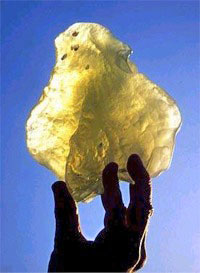 Libyan Desert Glass is classified by most meteoriticists with the group of
curious natural glasses known as tektites. In 1900, Professor Franz E. Suess
of Vienna coined the term tektite from the Greek tektos meaning "melted or
molten." Libyan Desert Glass is classified by most meteoriticists with the group of
curious natural glasses known as tektites. In 1900, Professor Franz E. Suess
of Vienna coined the term tektite from the Greek tektos meaning "melted or
molten."
Tektites are compositionally restricted, high silica, natural glasses
distinguishably different from other, volcanically derived, natural glasses.
Tektites range in size from microscopic (less than 1mm) to macroscopic
weighing many kilograms.
They exhibit a marvelous range of colors from water clear, gem quality, deep
forest greens of moldavites to the soothing pale to dark yellow and
yellow-greens of Libyan Desert Glass as well as the stygian, impenetrable
black of Australites.
Mankind has wondered about, and cherished, these enigmatic, exotic objects
for hundreds of years, perhaps much longer. In the Cro-Magnon Venus of Willendorf site (Austria), dated at 29,000 BC, small moldavite flake blades
were found (now lost!).
The earliest written records come from mid-10th century China referring to
the black, shiny objects found after rainstorms as lei-gong-mo, "inkstones
of the thunder-god". Australian Aborigines called Australites ooga, "staring
eyes".
The origin and source of tektites remains a mystery.
Back to Contents
This Libyan Glass Object was Found in
King Tut's Tomb
... in relation to all other tektite groups,
Libyan Desert Glass exhibits a noteworthy number of unique attributes.
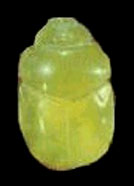 Lowest refractive index: 1.4616 Lowest refractive index: 1.4616
Lowest specific gravity: 2.21
Highest silica content: 98%
Highest lechatelierite particles: fused quartz
Highest water content: 0.064%
Highest viscosity: almost 6X greater than Australites at the same
temperature
Other unique attributes: Color, Bubble types: 100% of
included bubbles are lenticular or irregular.
..There is no evidence whatsoever, of atmospheric aerodynamic shaping
and it is therefore presumed that Libyan Desert Glass formed as a melt
sheet of some sort, possibly by meteoritic impact some 28.5 millions
years ago. Recent French studies concluded that meteoric elements in the
glass, of almost chondritic proportions, "points to an impact origin".
Interestingly, the inclusion of the high number
of lechatelierite (fused quartz) particles in Libyan Desert Glass also
points to an extremely high, up to 1700 C, formation temperature. Impacts of
large bodies at high velocity are certainly capable of creating such high
temperatures.
But, the central issue in determining the impact origin of tektites remains,
that is, how to transform a mass of crushed rock into a homogeneous and
relatively bubble free liquid which rapidly cools to a glass.
Even the commercial production of glass takes many hours to relieve the melt
of its volatile components. No partially melted material, or target rock
inclusions, have ever been found in Libyan Desert Glass.
Furthermore, other known impact glasses (impactites) such as Darwin Glass
are bubbly, frothy, scoriaceous and contain partially melted materials. So
the controversy continues.
Back to Contents
Scientists Discover Six Ancient Zones
of Depleted Uranium with Plutonium Products
If you could go back and read the news and scientific articles at the time,
you could contrast the shock, dismay and confusion caused by the initial
announcement that nuclear material had been mined in the past and that the
byproduct plutonium had been created at Oklo.
In 1972, a French analyst named Bougzigues working at the Pierrelatte
nuclear fuel processing plant detected a small but significant change in an
important ratio between Uranium 235 and Uranium 238. The proper ratio is
well known and well established in that field so that the change indicated
that something way out of the ordinary was going on.
The initial suspicion was that someone had included spent fuel in
with the recently mined ore.
This was quickly ruled out because there was no
radiation signature associated with the mystery uranium.
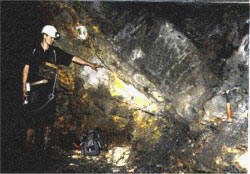 The
mystery uranium was eventually traced back to the Gabon mine at Oklo. You need to understand that what was so incredible was that a nuclear
reaction had occurred such that plutonium was created and that the nuclear
reaction itself had been “moderated”! The
mystery uranium was eventually traced back to the Gabon mine at Oklo. You need to understand that what was so incredible was that a nuclear
reaction had occurred such that plutonium was created and that the nuclear
reaction itself had been “moderated”!
This means that once a reaction is
initiated, if you want to harness the power output in a controlled manner,
you had better be able to keep it from exploding and releasing all the
energy at once.
This particular group of reactors was, incredibly moderated using..., water.
The first modern nuclear reactors used graphite and cadmium rods to moderate
their reactions.
At that time, people were speculating about aliens and
advanced ancient civilizations. Some months after the discovery rocked the
scientific world, someone came up with a somewhat dubious explanation which
over time has taken on the patina of absolute certainty. It was a natural
reactor which occurred billions of years ago.
There are at least six zones of depleted uranium (usually means mined)
and with
plutonium as a by product! You've got to really be trying to manufacture
plutonium - its a complicated process.
Yet, scientists studying these zones have a priori of course, decided not to
consider that man was involved:
-
They place its occurrence safely "billions" of years ago
-
They assume
that a breeding reaction could occur naturally when no such evidence of that
exists and creating a breeder reactor was once a technological holy grail
which was difficult to achieve on purpose
-
They theorize that although it
must have happened naturally in the distant past, that we need not worry
about it occurring now, as conditions differ
-
Nature designed the reactor
such that its spent fuel and dangerous byproducts were "contained"
Scientists use the
principle of uniformism to draw conclusions about the
future and the past.
If they cannot use this "principle", then they can not
draw any conclusions because they could not state that the conditions in the
universe that exist now, always existed.
Here though as often happens, they have to assume that the past was vastly
different as it related to the possibility of naturally occurring breeder
reactions.
Again, scientists from other countries were skeptical when first hearing of
these "natural nuclear reactors".
Some argued that the missing amounts of
U-235 had been displaced over time, not split in nuclear fission reactions.
"How," they asked, "could fission reactions happen in nature, when such a
high degree of engineering, physics, and acute, detailed attention went into
building a nuclear reactor?"
Perrin and the other French scientists concluded that the only other uranium
samples with similar levels of the isotopes found at Oklo could be found in
the used nuclear fuel produced by modern reactors.
They found that the
percentages of many isotopes at Oklo strongly resembled those in the spent
fuel generated by nuclear power plants, and, therefore, reasoned that a
similar natural process had occurred.
Back to Contents
Another View of the Phenomenon
Surprisingly, this uranium mine's nuclear reactor was well designed.
Studies indicate that this reactor was several miles in length. However, for
such a huge nuclear reactor, the thermal impact to its environment was
limited to 40 meters on all sides. Even more astonishing is the fact that
the radioactive wastes have still not migrated outside the mine site. They
are held in place by the surrounding geology.
Faced with these findings, scientists consider the mine to be a "naturally
occurring" nuclear reactor. The Oklo reactor has been documented for its
importance as an analogue (a structural derivative of a parent compound) in
the disposal of nuclear fuel wastes. But few people are bold enough to go
one step further.
As a matter of fact, many people today know that the reactor is a relic from
a prehistoric civilization. It's probable that two billion years ago there
was a fairly advanced civilization living at a place now called Oklo.
This civilization was technologically superior to today's civilization.
Compared to this huge "natural" nuclear reactor, our current nuclear
reactors are far less impressive. The question is: why did such a highly
advanced civilization disappear? That's something to ponder about.
The textbook of Basic Radioactive Chemistry (C. Claire ed.) used by Tsinghua University has the following paragraph:
"The natural uranium in the
Oklo
mine in Gabon, West Africa, contains an abnormal amount of U235. It is as
low as 0.29%, rather than the normal 0.72%. This means that many
self-sustained nuclear fission chain reactions took place at this mine about
two billion years ago.
Thirteen nuclear reactors existed in
prehistoric periods along the 200-metre
mine bed, and they were comparable to the modern nuclear reactor in power
and heat combustion. This mine had the capability of enabling self-sustained
nuclear chain reactions...."
This discovery, that shocked the entire
scientific community in 1972, has already been forgotten by people
today.
Back to Contents
OKLO: An Unappreciated Cosmic
Phenomenon
In 1972, French scientists discovered that several natural concentrations
of uranium ore had become critical and flared up some "2 billion" years ago
at Oklo, Gabon.
The concentration and configuration of the natural uranium and surrounding
materials at that time had been just right to sustain fission.
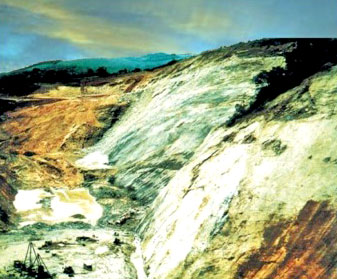
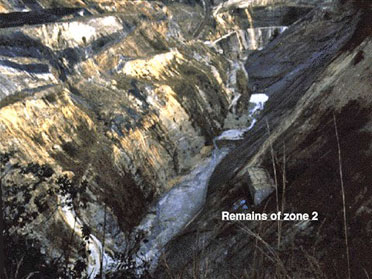
The Oklo Mines
In fact, the analysis of the nuclear waste in the burned rocks demonstrated
that plutonium had also been created.
This implies that natural breeder
reactors are also possible, raising the possibility of hitherto
unappreciated, long-lived heat sources deep in the earth, in the other
planets, and inside some of the stars.
Don't worry that the Oklo phenomenon might occur today on the earth's
surface. The concentration of fissionable U-235 has fallen considerably in
the last 2 billion years due to its radioactive decay. But, deep inside the
earth and other astronomical bodies, nuclear criticality might still be
possible due to different pressures, densities, etc.
In a stimulating and generally overlooked paper in Eos, J.M. Herndon
proffers four important natural phenomena that may involve natural fission
reactors.
Geomagnetic reversals
In the deep earth, where pressures and densities are
high, natural nuclear reactors may generate intermittent bursts of heat --
just as they did at Oklo -- and thereby cause the earth's dynamo to falter
and reverse.
Planetary heating
Jupiter, Saturn, and Neptune emit much more
energy than they receive from the sun. Natural nuclear reactors could be the
reason.
Stellar thermonuclear ignition
Astronomers assume that the high
temperatures required to ignite the thermonuclear reactions powering stars
come from gravitational collapse, but this source does not seem adequate to
some scientists. Nuclear fission reactors could ignite stars just as they do
H-bombs.
Missing matter
Natural nuclear reactors are finicky. There may be many star-sized,
non-luminous objects out there that were never ignited and that we cannot
see through our telescopes.
Back to Contents
 Evidence at Mohenjo-Daro Evidence at Mohenjo-Daro
When excavations of Harappa and
Mohenjo-Daro reached the street level, they
discovered skeletons scattered about the cities, many holding hands and
sprawling in the streets as if some instant, horrible doom had taken place.
People were just lying, unburied, in the streets of the city.
And these skeletons are thousands of years old, even by traditional
archaeological standards. What could cause such a thing? Why did the bodies
not decay or get eaten by wild animals? Furthermore, there is no apparent
cause of a physically violent death.
These skeletons are among the most radioactive ever found, on par with those
at Hiroshima and Nagasaki.
At one site, Soviet scholars found a skeleton
which had a radioactive level 50 times greater than normal.
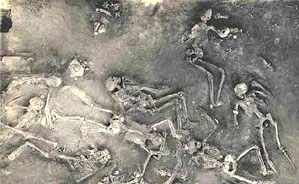
Other cities have been found in northern India that show indications of
explosions of great magnitude.
One such city, found between the Ganges and
the mountains of Rajmahal, seems to have been subjected to intense heat.
Huge masses of walls and foundations of the ancient city are fused together,
literally vitrified! And since there is no indication of a volcanic eruption
at Mohenjo-Daro or at the other cities, the intense heat to melt clay
vessels can only be explained by an atomic blast or some other unknown weapon. The cities were wiped out entirely.
While the skeletons have been carbon-dated to 2500 BC, we must keep in mind
that carbon-dating involves measuring the amount of radiation left. When
atomic explosions are involved, that makes then seem much younger.
Back to Contents
Giant Unexplained Crater Near Bombay
Another curious sign of an ancient nuclear war in India is a giant crater
near Bombay. The nearly circular 2,154-metre-diameter Lonar crater, located
400 kilometers northeast of Bombay and aged at less than 50,000 years old,
could be related to nuclear warfare of antiquity.
No trace of any meteoric material, etc., has been found at the site or in
the vicinity, and this is the world's only known "impact" crater in basalt.
Indications of great shock (from a pressure exceeding 600,000 atmospheres)
and intense, abrupt heat (indicated by basalt glass spherules) can be
ascertained from the site.
David Hatcher Childress
in Nexus Magazine
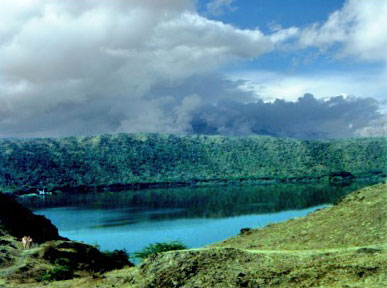
"The crater is formed in the basalt rock of thickness 600-700m (2,000 to
2,200 feet). This rock is made of many layers or flows which were laid why
volcanic activity at various times, five of such flows are exposed at the
crater rim. Thickness of these flows ranges from 5 to 30m.
The crater is about 150m (500 feet) deep and has average diameter of 1830m
(1.4 miles). The elevated rim consists of 25m of bedrock and 5m of ejecta
over it. This ejecta blanket is spread over about 1350m (4,400 feet) away
from the crater rim and slopes away by 2-6°. The uppermost region of ejecta
contains the deposits that were melted due to the impact"....
Lonar Crater - An Impact Crater
“Lonar is a place of obscurities, especially as the only meteoric crater
formed in basaltic terrain. It has remained relatively intact due to low
degree of erosion by environmental agents, making it an excellent model for
study. However, several strange things happen here:
1. The lake has two distinct regions that never mix - an outer neutral (pH7)
and an inner alkaline (pH11) each with its own flora and fauna. You can
actually do a litmus paper test here and check this for yourself.
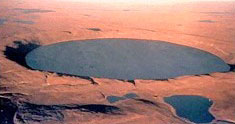
2. There is a perennial stream feeding the lake with water but there seems
to be no apparent outlet for the lake’s water. And it is also a big unsolved
mystery where the water for the perennial stream comes from, in a relatively
dry region like Buldhana. Even in the driest months of May and June, the
stream is perpetually flowing.
Lonar generates questions and more
questions”.
Lilyn Kamath
Back to Contents
A Nuclear Catastrophe in Paleoindian Times?
Introduction
We introduce here a remarkable theory of terrestrial catastrophism that seems to be supported by evidence that is equally
remarkable. One of the authors of this theory (RBF) is identified as a
nuclear scientist at the Lawrence Berkeley Nuclear Laboratory.
The second author (WT) is a consultant. The authors' credentials seem so
good that we must take a close look at their extraordinary claims concerning
a natural phenomenon that they believe reset radiocarbon clocks in
north-central North America and---potentially---elsewhere on the planet.
We will be most interested in the reception accorded these claims by the
scientific community.
The claims
In the authors' words:
Our research indicates that the entire Great Lakes
region (and beyond) was subjected to particle bombardment and a catastrophic
nuclear irradiation that produced secondary thermal neutrons from cosmic ray
interactions.
The neutrons produced unusually large quantities of ^239 Pu and
substantially altered the natural uranium abundances (^235 U/^238 U) in
artifacts and in other exposed materials including cherts, sediments, and
the entire landscape.
These neutrons necessarily transmuted residual nitrogen (^ N) in the dated
charcoals to radiocarbon, thus explaining anomalous dates.
Some North American dates may in consequence be as much as 10,000 years too
young. So, we are not dealing with a trivial phenomenon!
Supporting evidence
Four main categories of supporting evidence are claimed and presented in
varying degrees of detail.
-
Anomalously young radiocarbon dates in north-central North America.
Example: the Gainey site in Michigan. [Other map sites include Thedford &
Zander, Ont.; Potts, NY; Shoop, Penn.; Alton, Ind.; Taylor, Il.; Butler &
Leavitt, Mich.; and far to the north Grant Lake, Nunavut; and in the far
southwest Baker, N.M. - TWC]
-
Physical evidence of particle bombardment.
Example: chert artifacts with high densities of particle-entrance wounds.
-
Anomalous uranium and plutonium abundance ratios in the affected area.
-
Tree-ring and marine sediment data.
The authors claim that the burst of radiation from a nearby supernova, circa
12,500 years ago, not only reset radiocarbon clocks but also heated the
planet's atmosphere, melted ice sheets, and led to biological extinctions.
If verified, the claimed phenomenon would also "reset" archeological models
of the settlement of North and South America. To illustrate, we may have to
add as many as 10,000 years to site dates in much of North America!
(Firestone, Richard B., and Topping, William: "Terrestrial Evidence of a
Nuclear Catastrophe in Paleoindian Times")
Comment
Thus we add another potential cause of an often-hypothesized
12,500-BP catastrophe that is said to have changed the world's history.
Competing theories involve asteroid impact, volcanism, a Venusian
side-swipe, etc.
Back to Contents
Desert Glass Scarab. What produced the intense heat in the desert?
Tutunkhamun's Fireball, made by production company TV6, was
broadcast on BBC Two on Thursday, 20 July
In 1996 in the Egyptian Museum in Cairo, Italian mineralogist Vincenzo de
Michele spotted an unusual yellow-green gem in the middle of one of Tutankhamun's necklaces.
The jewel was tested and found to be glass, but intriguingly it is older
than the earliest Egyptian civilization.

Working with Egyptian geologist Aly Barakat, they traced its origins to
unexplained chunks of glass found scattered in the sand in a remote region
of the Sahara Desert.
But the glass is itself a scientific enigma. How did it get to be there and
who or what made it? The BBC Horizon programme has reported an extraordinary
new theory linking Tutankhamun's gem with a meteor.
Sky of fire
An Austrian astrochemist Christian Koeberl had established that the glass
had been formed at a temperature so hot that there could be only one known
cause: a meteorite impacting with Earth. And yet there were no signs of a
suitable impact crater, even in satellite images.
American geophysicist John Wasson is another scientist interested in the
origins of the glass. He suggested a solution that came directly from the
forests of Siberia.
"When the thought came to me that it required a hot sky,
I thought immediately of the Tunguska event," he told Horizon.
In 1908, a massive explosion flattened 80 million trees in
Tunguska,
Siberia. Although there was no sign of a meteorite impact, scientists now
think an extraterrestrial object of some kind must have exploded above
Tunguska.
Wasson wondered if a similar aerial burst could have produced enough heat to
turn the ground to glass in the Egyptian desert.
Jupiter clue
The first atomic bomb detonation, at the Trinity site in New Mexico in 1945,
created a thin layer of glass on the sand. But the area of glass in the
Egyptian desert is vastly bigger.
Whatever happened in Egypt must have been much more powerful than an atomic
bomb.
Impact Simulation
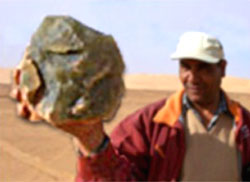 image
right - Barakat holds up one of the many, huge chunks of glass in the desert. image
right - Barakat holds up one of the many, huge chunks of glass in the desert.
A natural airburst of that magnitude was unheard of until, in 1994,
scientists watched as
comet Shoemaker-Levy collided with Jupiter. It
exploded in the Jovian atmosphere, and the Hubble telescope recorded the
largest incandescent fireball ever witnessed rising over Jupiter's horizon.
Mark Boslough, who specializes in modeling large impacts on supercomputers,
created a simulation of a similar impact on Earth.
The simulation revealed that an impactor could indeed generate a blistering
atmospheric fireball, creating surface temperatures of 1,800C, and leaving
behind a field of glass.
"What I want to emphasize is that it is hugely bigger in energy than the
atomic tests," said Boslough. "Ten thousand times more powerful."
Defence Lessons
The more fragile the incoming object, the more likely these airborne
explosions are to happen.
In Southeast Asia, John Wasson has unearthed the
remains of an event 800,000 years ago that was even more powerful and
damaging than the one in the Egyptian desert; one which produced multiple
fireballs and left glass over three hundred thousand square miles, with no
sign of a crater.
"Within this region, certainly all of the humans would have been killed.
There would be no hope for anything to survive," he said.
According to Boslough and Wasson, events similar to
Tunguska could happen as
frequently as every 100 years, and the effect of even a small airburst would
be comparable to many Hiroshima bombs.
Attempting to blow up an incoming asteroid, Hollywood style, could well make
things worse by increasing the number of devastating airbursts.
"There are hundreds of times more of these smaller asteroids than there are
the big ones the astronomers track," said Mark Boslough. "There will be
another impact on the earth. It's just a matter of when."
Back to Contents
Oklo Conversation
by Anthony James
2006
William: “Ahhh. Look at what the wind blew in. How ya doin”?
Robert: “Must have been an ill wind, huh”?
William: “Nah, not at all. Good to see you! Pull up a chair. Everyone
else has deserted me out here. How’s the wife and kids”?
Robert: “She’s fine. She still doesn’t know it’s me that’s been spying
on her and following her around. Someday I’m going to marry that girl
and -I’ve got my eye on a coupla kids I think she’s really going to
like, as well! Hey! What’re we having? Smoked turkey? I guess, you being
a Christian and all will have to pass on it? I mean cannibalism is a
sin, right”?
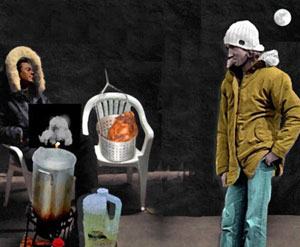
William: “That’s very droll, Rob. I suppose you’ll be very happy to hear
for the exact same reasons that there will be two turkeys and no ham?,
You know that when it gets hot out people around you always think they
smell bacon”.
Robert: “Touche”!
William: “Not that I’m keeping track, but that’s actually “three che”.
Robert: “Touche”!
William: “If you insist. Did you know Dad is coming by? That’s why I was
surprised to see you here.”
Robert: “Yeah, he’s already here. That’s one of the reasons I’m out here
in the cold with you. I wasn’t gearing up to have to see him until over
at the house tomorrow”.
William: “You still haven’t forgiven him for turning his back on your
religion, huh”?
Robert: “Atheism isn’t a religion and it’s not even about that”.
William: “You know he’s coming to church with me these days”?
Robert: “Yeah. Uncle Mike must be turning over in his grave”
William: I don’t believe Uncle Mike is dead. As a matter of fact, he was
upstairs stuffing his face when I came out here”. Besides, do Atheists
believe in consciousness after death?
Robert: “Yeah, well he’s not looking too good and he’s still drinking
like a fish. You know he breaks out in hives if he just drives by a
church- or, of course, if his blood alcohol drops below .08. Actually, I
think he blames his falling out of recovery on your becoming a
Christian.”
William: “I think he drinks because he needs to in order to continue to
be an “intellectually fulfilled Atheist”. You do remember that time as
kids when we saw him praying over Mom when she was sick in the
hospital”?
Robert: “That was no hospital, that was Kaiser. And he swears that he
was- throwing up a rum and diet coke. If he knew you were still doubting
his story he’d be turning over in his grave right now. Plus, if he was
praying, it didn't do much good, did it"?
Robert: After a few minutes of companionable silence: “So, did you get
my e-mail? The one about Oklo”?
William: “Oh, man! I should have known why you made a beeline out here!
I thought maybe you were out here just to hang out. Please tell me that
you don’t want to get involved in yet another evolution/creation
debate”?
Robert: “No, not so much a debate. A discussion”.
William: ”Let’s save some time, why don’t you just stalk off”?
Robert: "I've got the goods, this time! Well, I always had the goods but
this information I think you’ll find is very compelling evidence for an
“old universe” and an “old earth””. He pulled some folded pages from his
back pocket.
William: “For crying out loud! You brought the e-mail with you to a
family celebration just so we could argue about it? Look I’m not sure
that this is a good time for this, I’m frying a turkey, here”.
Robert: “Yeah well I’m trying to fry a turkey, too, bro. Would you be so
kind as to pass me the peanut oil and close your eyes”?
He began to read:
“In the early 1970s, French scientists noticed
something odd about samples of uranium recovered from the Oklo mine in
Gabon, West Africa. All atoms of a specific chemical element have the
same chemical properties, but may differ in weight; these different
weights of an element are known as isotopes. Some uranium samples from
Gabon had an abnormally low amount of the isotope U-235, which can
sustain a chain reaction. This isotope is rare in nature, but in some
places, the uranium found at Oklo contained only half the amount of the
isotope that should have been there.
Scientists from other countries were skeptical when first hearing of
these natural nuclear reactors. Some argued that the missing amounts of
U-235 had been displaced over time, not split in nuclear fission
reactions. "How," they asked, "could fission reactions happen in nature,
when such a high degree of engineering, physics, and acute, detailed
attention went into building a nuclear reactor?"
Perrin and the other French scientists concluded that the only other
uranium samples with similar levels of the isotopes found at Oklo could
be found in the used nuclear fuel produced by modern reactors. They
found that the percentages of many isotopes at Oklo strongly resembled
those in the spent fuel generated by nuclear power plants, and,
therefore, reasoned that a similar natural process had occurred.”
…. The uranium in the Earth contains dominantly two uranium isotopes,
U-238 and U-235, but also a very small percentage of U-234, and perhaps
small, undetectable amounts of others. All of these isotopes undergo
radioactive decay, but they do so at different rates. In particular,
U-235 decays about six-and-a-third times faster than U-238. Thus, over
time the proportion of U-235 to U-238 decreases. But this change is slow
because of the small rates of decay.
Generally, uranium isotope ratios are the same in all uranium ores
contained in nature, whether found in meteorites or in moon rocks.
Therefore, scientists believe that the original proportions of these
isotopes were the same throughout the solar system. At present, U-238
comprises about 99.3 percent of the total, and U-235 comprises about 0.7
percent.5 5 Any change in this ratio indicates some process other than
simple radioactive decay.
Calculating back to 1.7 billion years ago—the age of the deposits in
Gabon—scientists realized that the U-235 there comprised about three
percent of the total uranium. This is high enough to permit nuclear
fissions to occur, providing other conditions are right.”
William tried to speak. Robert held up his hand.
Robert: “Hold on! That was from. A G.Cowan, in Scientific American. Just
a few more quotes and then let me place them in a context, and I’ll let
you have the floor”. He continued: “
“Ultimately, the mystery was unraveled, when it was discovered that in
the pockets of depleted uranium ore a characteristic spectrum of
byproducts of nuclear fission were also present and in the distinctive
ratio that might be anticipated if a natural fission reactor had
produced them.
The U-235 from Oklo had been depleted partly because it had become the
fuel of the reactor. It had also dwindled through time, simply by its
own radioactive decay.
By calculating how long ago the U-235 had been sufficiently concentrated
to fuel a chain reaction, the scientists were able to date the time it
was operating to 2 billion years ago, about the age of rocks in which
the uranium ore was found”.
“Next”, he said is this quote from Don Lindsay: “Another evidence is the
natural nuclear reactor at Oklo, in Gabon. This reactor was actually
just an unusually rich body of radioactive ore. So rich, in fact, that
when it was formed, it approached critical mass. Studies of the unusual
elements found there indicate that reactors acted the same two billion
years ago as they do now. If the fine structure constant had been
different by as little as one part in a million, the Oklo measurements
should have detected that”.
Robert continued:
“The point of all this is the following. To me, it’s
not bad enough that you’re a creationist, but you are a young earth
creationist! If this information does not make a dent with you in terms
of creationism, at the very least it should either convince you or
create some severe doubts in your mind about a young earth! I say this
because the Oklo natural reactors are real, the nuclear reactions did
occur, and could only have done so approximately 2 billion years ago
when the uranium would have been sufficiently enriched. “
“Finally”, he concluded, “the mutagenic radiation from such natural
reactors some 2 billion years ago could have been a major driving force
in evolution!
Robert waited a moment but William hadn’t made a response. “Go on”, he
said.
William: “Oh, I can speak now? Thanks, but I’m not even sure where to
start”.
Robert: “Yeah, this is a tough one for creationists. I know of one guy
who was formerly a young earth creationist who has become a “theistic”
evolutionist” and “old earther”, just because he couldn’t come up with a
“young earth” explanation for Oklo. Not only that, I sent you a
newsgroup item where it showed that they pretty well savaged Dembski’s
intelligent design filter because Oklo meets many of the criteria for
intelligent design even though obviously, it was a natural phenomenon.”
William: “Yeah, no. I’d heard about Oklo years ago. Plus I did read all
the stuff in your e-mail. It’s just that this will be our 1,000th
discussion on these sort of topics and history tells me that even after
hours of discussion, neither one of us is going to change his beliefs
one bit. I don’t feel like I’ve got that kind of time, plus it’s cold,
plus I’ve got to focus on frying this turkey and plus that other bird is
going to freeze if I don’t get it in the house”.
Robert: "Okay, we’ll save the full discussion for e-mail. Just give me
some of your initial thoughts because frankly, I don’t think there is an
adequate young earth response to the Oklo phenomenon.. Wait one minute,
and I’ll run your turkey inside. Get your thoughts together in the
meantime”.
William: “You’re offering to help? You? Ahh! You’ve had too many beers
yourself huh? You’ve got to go potty!”
Robert: “Like its 1999. Get your little fundamentalist thoughts
together, and I’ll be right back”!
When Robert came back he handed a tumbler to
William.
William: What’s this?”
Robert: “Some hot chocolate. You’re welcome”.
William: Thanks! Umm. Do Atheists wash their hands? Cuz, you know,
though its not in the Bible, they say; cleanliness is next to
...Godliness. Oh, and tell me this? I've always wondered; what do I say
if you sneeze?!
Robert: "You simply apologize for forgetting about my allergy to cheap
cologne."
William: "And it was so thoughtful of you to have given it to me for my
birthday-even if it was only three quaters full. So, okay, back to the
discussion; let me start with this. This whole science thing. This thing
where we Christians try to approach the origin of ourselves and the
universe in a “scientific” way is for your benefit only. We find it
limiting, but because you claim that you can only see the universe
through a particular lense, we try to accommodate you. we try to speak
the language you say you can understand, while a more perfect language
is set aside. We’re speaking baby talk here.”
Robert: “Gratuitous insult.” You’re simply saying that you don’t need
evidence.
William: "We do need evidence, I’m just not limited to what you call
evidence. Imagine if someone says that they could only understand love
if they can put it into some kind of scientific formula, or measure it
out to prove it experimentally? “Science “can tell us little about the
appreciation of a sunset, about the soul of man or so many other things.
For that matter, science can tell us very little about the mind itself.
The thing is, science can only begin after the universe and the creation
already exist. Science can tell us nothing about what happens before
that. In fact, let me say this; science begins after creation. The first
law of physics, conservation of matter and energy says matter and energy
can neither be created nor destroyed. This tells you that science does
not know how matter came into existence. It should also tell you that if
matter cannot be created under the laws of this universe, that something
outside the 1st law created matter and energy. The most important law of
science itself points to a “special creation” outside of science .”
Robert: "You are going to talk about Oklo, right?
William: “Special Creation” however, is something that happens
“pre-science”. The fact of the matter is, if you were inclined to stick
exclusively to science, the 1st law would turn you away-it tells you not
to look here in science because all we can tell you is that all this
matter you see..? It can’t be created! If you want to know about
creation, you have to look outside of science”.
Robert: ”Oklo”?
William: "Okay. For all the years we’ve been talking about this, I’ve
been consistent about what I believe, Seven actual days, special
creation, i.e. God did it, He is the creator, a global worldwide flood ,
a young earth. Right.” Now, consistent with that, the laws of the
universe are now set. But consistent with my beliefs, when Adam and Eve
were created there was no death.
By the way, I've been consistent but
whether you realize it or not, you've been nothing but. Whatever you
assert confidently about evolution, or the universe or the "big bang" is
likely to be changed the next time. I saw an article yesterday that I
didn't read that says the big bang needs to be moved back 2 billion more
years. Me, I'm sticking with created in seven days. You know what Rob,
I'll tell you the same tomorrow.
To be more specific about the 1st and 2nd laws of physics, my assumption
is that in the beginning, the 1st law was set, but not the second, which
is entropy…systems over time will lose energy and become less organized.
I believe entropy came into existence after the fall. That is, death was
introduced into this world; the spiritual death of man, the physical
death of man and animal, and the beginnings of the physical death of the
universe. At the beginning death was not part of the plan, nor was the
winding down of the creation.
I’ll come back to this point.
Now, Oklo, okay? Materialists have available to them only one solution
for the Oklo phenomenon; a naturalistic one. Nothing else fits
uniformism and gradualism. On the other hand, Christians certainly can’t
accept a natural explanation, particularly if it is one that takes 1.8
billion years to occur. Neither Christians nor evolutionists apparently
considered the idea of sophisticated civilizations prior to the flood of
Noah. Well, evolutionists wouldn't but even Christians who believe in
the flood tend to think of the pre-flooders as nomadic herdsmen with no
technology.
For that reason, the very first thing that should have occurred to both
groups about Oklo did not. Occam’s Razor (when there are multiple
explanations- choose the simplest one) should have led to the
conclusion-or at least the consideration that this was a “designed
system” and not a natural one!
Even though materialists were “freaked out” by the discovery and even
though as you read the scientific world initially resisted the idea of a
natural reactor they never for a minute considered the idea that “cave
men” (because of their view of earlier man) could have built a breeder
reactor!
But consider; this reactor produced energy comparable to a modern
nuclear reactor, was moderated by water so that the reaction could be
controlled, and to this day still contains the waste products from the
reactor. In short, this system was “well designed”, whether by nature or
by man!. I submit to you that to believe it was built by aliens makes
more sense to me than the idea that somehow nature built it (I don’t
believe aliens exist).
To say that you accept the idea that it was a natural phenomenon rather
than a designed reactor proves that you probably don’t know how much
technology went into building a working breeder reactor.
As for Dembski’s design filter; Dembski himself probably never
considered that the reason his filter might “select” the Oklo reactor as
a product of design is that it is in fact a product of design!
Robert: "You can’t be serious”!?
William: "Look! I’m not saying that the reactors were designed and built
by man as a certainty. Whether or not it was or wasn’t does not impact
me as a Christian. I’m saying that this should have been the very first
thing considered or that it should have at the very least been on the
list. I can send you a link later on of some creation scientists who
accept the idea that it is natural reactor but who show that it could
still have happened in the context of a young earth, but A mistake being
made here is the idea that technology will always look the same—that
advanced technology had to take the form that it did in this present
age.
Let me ask you this; if you had to direct a team and the resources to
build the great pyramid with the technological level and tools we say
were available to the supposed builders thereof, the Egyptians (and
whatever you may think, there is no firm evidence in any way that
connects the pyramids of the Giza plateau to the dynastic Egyptians) —or
you had to direct the team and resources to place a man on the moon with
the technology we had in the sixties , which challenge would be more
difficult?
Do not be so quick to choose landing a man on the moon with the
technology available at that time. In order to build the pyramid, you
would have had quarry and then move 2.3 million granite or limestone
blocks weighing between 2.5 and 50 tons, 600 miles to the site of the
pyramid. Keep in mind that the copper and bronze tools experts say the
Egyptians used to precisely cut the stone blocks are softer than the
limestone and granite blocks.
Keep in mind that you will need to lift
and precisely place granite blocks, some again weighing nearly 50 tons,
to a height of nearly 500 feet. That's 50 stories. These stones will
need to be placed with such tolerances that a razor blade will not fit
between them Your pyramid will when finished line up with the four
points of the compass with an accuracy of .06 degrees, without a
compass.
Your team will need to level the 13-acre limestone bedrock base to a
degree of accuracy only recently achieved with laser technology using
only the known technology of the Dynastic Egyptians. Among technological
attributes too numerous to mention, your team will have to excavate
what’s known as the ‘Descending Passage’ some 350 feet into solid
bedrock using copper and bronze tools, at a 26-degree angle all the
while keeping the tunnel arrow-straight for its entire length”!
Robert: (Feigning a yawn?) “Thanks! That’s fascinating! Not! Look, can
you please tell me how you moved from the Oklo natural reactor to a man
made triangle? I really want you to focus Billy if you can. How do you
react to the information I provided about Oklo?
William: “My point is, there is evidence of ancient high technology
other than the ancient nuclear facility at Oklo”.
Robert: "Look, I’ll bite. The technology that built the great pyramid is
in no way comparable to the technology or effort it took to put a man on
the moon. I guess that means that I would take the pyramid. Give me
enough slave labor and I’ll bring it in on time and under budget! The
moon landing on the other hand required computers-much higher
technology”!
William: "I don't think millions of unskilled slave laborers are going
to help you build one of the seven wonders of the ancient world. How
could you do it when experts are still arguing about how it was done in
the first place? The point is, the choice is not a foregone conclusion.
If you accept the dating of the current experts on the great pyramid,
then for more than 5,000 years this precisely built yet huge structure
was the tallest structure built by man. It’s been less than two hundred
years since its height was surpassed. It’s almost 50 stories high and is
built to a much higher precision that any modern high-rise!”!
Robert: “Moving on to Oklo:…?
William: ”What makes me laugh is the example we "creationists" use re:
the tornado in the junkyard. The idea that the odds of evolution working
to produce the diversity of life on earth would be like a tornado coming
through a junkyard and completely assembling a 727. The problem is, we
underestimate the gullibility of materialists! I mean, you’ll take those
odds every time if it means that you don’t have to get down on your
knees to worship God!
If you and I could observe that junkyard and watch a billion years worth
of tornados producing not so much as a ninety degree angle, I bet I know
exactly what you’d say”…
Robert:: And that is…
William: :”Best two billion out of three”!?
Robert: ”Rimshot”!
William: ”Your faith is almost inspirational. Okay. How did they
conclude that the “natural reactor” was active nearly 2 billion years
ago? I’ll tell you how. By making the assumption that the nuclear decay
rate or half-life of U235 has always remained constant. In other words,
if the present laws and constants of nature had extended throughout the
past, the Oklo uranium deposit could have become critical close to 2
billion years ago. Additionally, the conditions for a moderated reaction
do not exist today and must be assumed to have existed in the past.
So,
this is what happened re: Oklo. 1) Freak out. 2)Sweat. 3)Come up with a
“natural” explanation which at first was met with a pronounced
skepticism but which later would become dogma, i.e.’ darwinism, the big
bang theory, dark matter, continental drift and Cold Play”!
Robert: "Cold Play”!
William: 4)Gradually rally around the natural explanation because
really, what else have you got. 5)Dogma. 6) Verify that constants are
“constant” by using constants to arrive at a date a “natural” reactor
was in operation. 7)Turn around and use Oklo with your new assumption
generated numbers to prove that constants have always been constant!
8)Try to taunt creationists with your proof”!
Christians on the other hand should know consistent with their belief in
both the “fall” and the flood have accepted a view that is completely
opposed to uniform assumptions. Our view has always been catastrophic.
Who knows how submersion in water for up to a year or more is going to
impact radiometric dating? Logically, both the fall of man and the flood
eliminate uniformism.
This last part is to address the idea that there are Christians who’ve
been impacted by the Oklo phenomenon in terms of their faith. You said
some of them have been cowed by it and I’m just saying that perhaps they
haven’t fully thought out what the implications are of their belief in
the Biblical teachings on the history of the planet and the creation of
the universe”.
Robert: "To be honest, I feel like you’re weaseling out of the Oklo
implications, here. The one thing you’ve said which I will need to go
and research is the idea that to arrive at an Oklo date they assumed
constants were constant. That doesn’t seem unreasonable to me because ;
what else could they assume”.
I will however agree that you can’t then
go back and say Oklo proves that the constants were always constant. The
idea that little green men built themselves a breeder reactor belongs on
Stargate SG-1, which I know you watch, by the way.”
William: "You do know that there has been research indicating that the
speed of light and other constants have or are changing? One of those
studies even focused on Oklo, though they didn’t suggest a magnitude
change in the constants.
Would you also agree that if today the fact that matter and energy are
“conserved” indicates that there was a time before the present physical
laws in this universe were set that another law, permitting the creation
of matter must have been in effect”?
Robert: The Big bang….
William:” The Big bang was invented by someone who believed in the
creation theory. I believe he was a minister who thought the big bang
evidence supported the idea that God created the universe. However, the
big bang couldn’t have created matter, it was how matter was dispersed,
wasn’t it”?
Robert: "I'll get back to you on that”.
William: "Continuing to respond to your Oklo information. You mentioned
mutation. The idea that radiation from the nuclear reactor sped up
evolution. I suppose I can’t just say “that’s dumb” and go back to
frying this turkey? It is you know.
Mutation is bad for organisms, not good. Mutation destroys information,
it does not add new information. This means that entropy, not only is at
work in the universe, it is also at work on the genome. Ironically the
very thing that evolutionists believe is responsible for building on the
genome and increasing information is doing the exact opposite.
In fact, mutation in humans is much more frequent as previously thought.
The human genome is gradually being destroyed by mutation. A population
geneticist named “Crow” (and he’s on your team) estimates that humans
are experiencing an irrevocable net loss of genetic information such
that the “fitness” is declining by 1% to 2% per generation. This means
that eventually, the human genome will lose too much information for the
human race to continue. Read Remine’s book on Haldane’s Dilemma or
Sanford’s Genetic Entropy. This of course has implications for the
future and the past. In 8 generations, or 200 years human fitness may
decline as much as 16% from today. Now if you take these numbers the
other way; how old could the human race be?
Neanderthal and Cro-Magnon were physically stronger, had better eyesight
(based on paintings in dark caves with no evidence of soot) and had
larger brains. Our descendants will be much less robust than
ourselves-if the Lord hasn’t come by that time.”
Robert: ”I believe I will find your picture in the dictionary under
digress”! Let’s eat turkey tonight and finish this discussion by e-mail.
I’m going to get some more material and stay focused on Oklo. I think I
can make some progress with you on this because it is so conclusive”!
William: “At your current rate of “progress”, should it remain
constant, you’ll accomplish nothing in 2 billion years”.
Back to Contents
|



 kilometers. The
clear-to-yellowish-green pieces are concentrated in sand-free corridors
between north-south dune ridges.
kilometers. The
clear-to-yellowish-green pieces are concentrated in sand-free corridors
between north-south dune ridges.
 Libyan Desert Glass is classified by most meteoriticists with the group of
curious natural glasses known as tektites. In 1900, Professor Franz E. Suess
of Vienna coined the term tektite from the Greek tektos meaning "melted or
molten."
Libyan Desert Glass is classified by most meteoriticists with the group of
curious natural glasses known as tektites. In 1900, Professor Franz E. Suess
of Vienna coined the term tektite from the Greek tektos meaning "melted or
molten." Lowest refractive index: 1.4616
Lowest refractive index: 1.4616  The
mystery uranium was eventually traced back to the Gabon mine at Oklo. You need to understand that what was so incredible was that a nuclear
reaction had occurred such that plutonium was created and that the nuclear
reaction itself had been “moderated”!
The
mystery uranium was eventually traced back to the Gabon mine at Oklo. You need to understand that what was so incredible was that a nuclear
reaction had occurred such that plutonium was created and that the nuclear
reaction itself had been “moderated”! 

 Evidence at Mohenjo-Daro
Evidence at Mohenjo-Daro 



 image
right - Barakat holds up one of the many, huge chunks of glass in the desert.
image
right - Barakat holds up one of the many, huge chunks of glass in the desert.